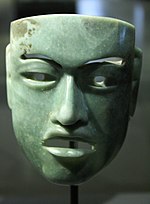User:Bigmoney/SandboxNationalTreasure
Jump to navigation
Jump to search
National Treasure (Pulacan)
A National Treasure (Nahuatl: teocuitla cecnitlacayoh, SePala: Y) is a tangible site, artifact or cultural work deemed to have pre-eminent value by the government of Pulacan. There are eighteen National Treasures, kept consistent since their first introduction in 1961. It is the highest such designation issued by the Secretariat of Cultural Affairs. The number of artifacts is significant, corresponding with the number of months in the Nahua calendar used in Pulacan. The designation of certain National Treasures has generated some controversy.
List
| No. | Image | Name | Location | Type | Description |
| 1 | 
|
Cuamochicpac Historic Town | Cuamochicpac altepetl, Etlazoco Department | Artificial site (town) | Cuamochicpac is a temazcalaltepetl, a type of town centered around a temazcal or mineral hot springs and renowned for having spiritual and scenic locations. The site of the springs bears archaeological evidence of ritual worship dating back to the 1st century BCE; indigenous beliefs and Cozauist temples alike see major festivals celebrated at the site. The town is also listed for its well-preserved centuries-old public baths, still in use despite the modern rise of in-home bathing. The site is therefore linked not only to Pulacan's religious history, but to the traditional practices of communal bathing and their associated rituals as well. |
|---|---|---|---|---|---|
| 2 | Sword of kgosi Matsieng | National Museum of the Ngwato People Kaudwane altepetl, Tshokwe Department |
Artifact (weapon) | One of Great Ngwato's most renowned kings (SePala: dikgosi, sing. kgosi) was Matsieng. Ruling from 10XX to 10XX, he later became a semi-mythological founding ancestor for many people claiming modern-day Ngwato heritage. The sword is said to have been wielded by the king until his death, whereby it became part of The selection of this object as a National Treasure, as well as its provenance and history, have been the subject of controversy. | |
| 3 | 
|
||||
| 4 | 
|
Chinampan of the Noka Basin | Noka River basin
Noka Botlhabatsatsi and Noka Bophirimabatsatsi Departments |
Artificial site (earthworks) | The Chinampan is the region of chināmitl, an artificial farm island surrounded by canals, along the basin of the Noka River. Much of the wetlands surrounding the river have been converted to this type of farmland, a process begun before the Common Era but rapidly accelerated under orders from Itzcoatl and later Angatahuacan governments. The Chinampan's design features not only encourage multiple harvests but lessen the environmental impact on the Noka wetland compared to other agricultural development techniques. The Chinampan is one of Pulacan's most agriculturally-productive regions, despite its relatively low population. |
| 5 | 
|
Censer | Artifact (religious, ceremonial or artistic) | ||
| 6 | 
|
Jade mask, x Period (12th-14th centuries) | National Archaeology Museum Aachanecalco<br/>Aachanecalco altepetl, Topocueyoco Department | Artifact (religious, ceremonial or artistic) | A jade mask that was likely gifted from a Heron Empire administrator to an unknown colonial-era Pulatec notable. Jade as a material was not reliably available in Pulacan until conquest by the Angatahuacans; |